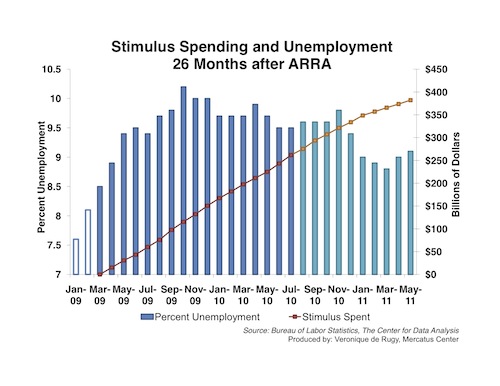- | Government Spending Government Spending
- | Data Visualizations Data Visualizations
- |
Stimulus Spending and Unemployment
26 months after ARRA
This chart presents an updated look at stimulus spending and unemployment based on the most recent data from the Bureau of Labor Statistics and Center for Data Analysis.
This week, Senior Research Fellow Veronique de Rugy gives an updated version of stimulus spending and unemployment based on the most recent data from the Bureau of Labor Statistics and the Center for Data Analysis. The administration’s promise that the ARRA bill would keep unemployment rates from breeching 8.8 percent and would create some 3 million jobs—90 percent of which would be in the private sector – did not materialize.
The unemployment rate started at 7.6 percent when President Obama took office and peaked at 10.2 percent in October of 2009. Since the enactment of the American Recovery and Reinvestment Act (ARRA) in February 2009, unemployment has not approached pre-ARRA unemployment rates again. Currently, $382 billion have been made available by government departments and agencies, yet, unemployment has not significantly decreased. In fact, the latest data from the Bureau of Labor Statistics shows a slight increase in the unemployment rate from 9 percent in April to 9.1 percent in May.
At 9.1 percent, today’s unemployment rate is far too high. In the past two months unemployment has begun to edge up again - In spite of growing unemployment and the lack of recovery, stimulus spending continues to grow. While debate surrounds the effect of stimulus spending on unemployment, the data reveal no marked improvement in employment as stimulus spending has increased. Sustainable job creation comes from the private sector; true stimulus legislation is that which creates a stable, low-regulatory regime that will enable businesses to hire workers in sustainablejobs; jobs that will last long after stimulus funds have run out.


